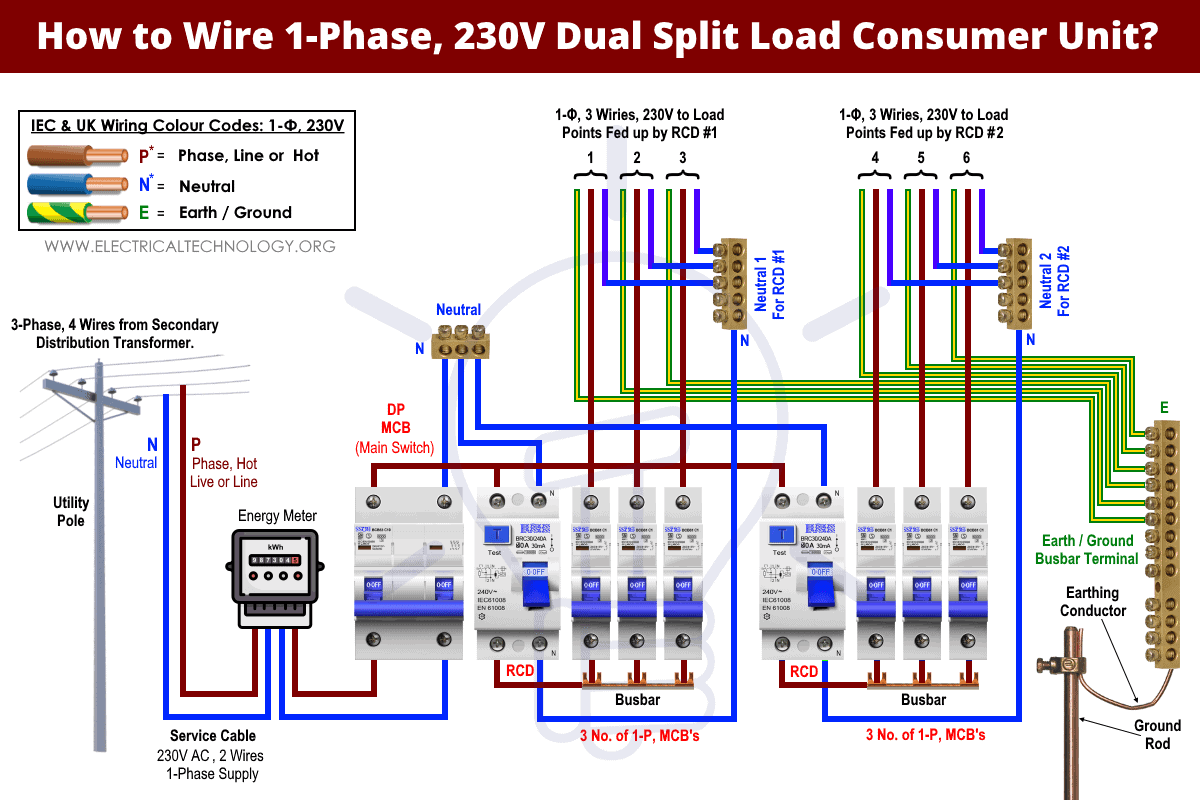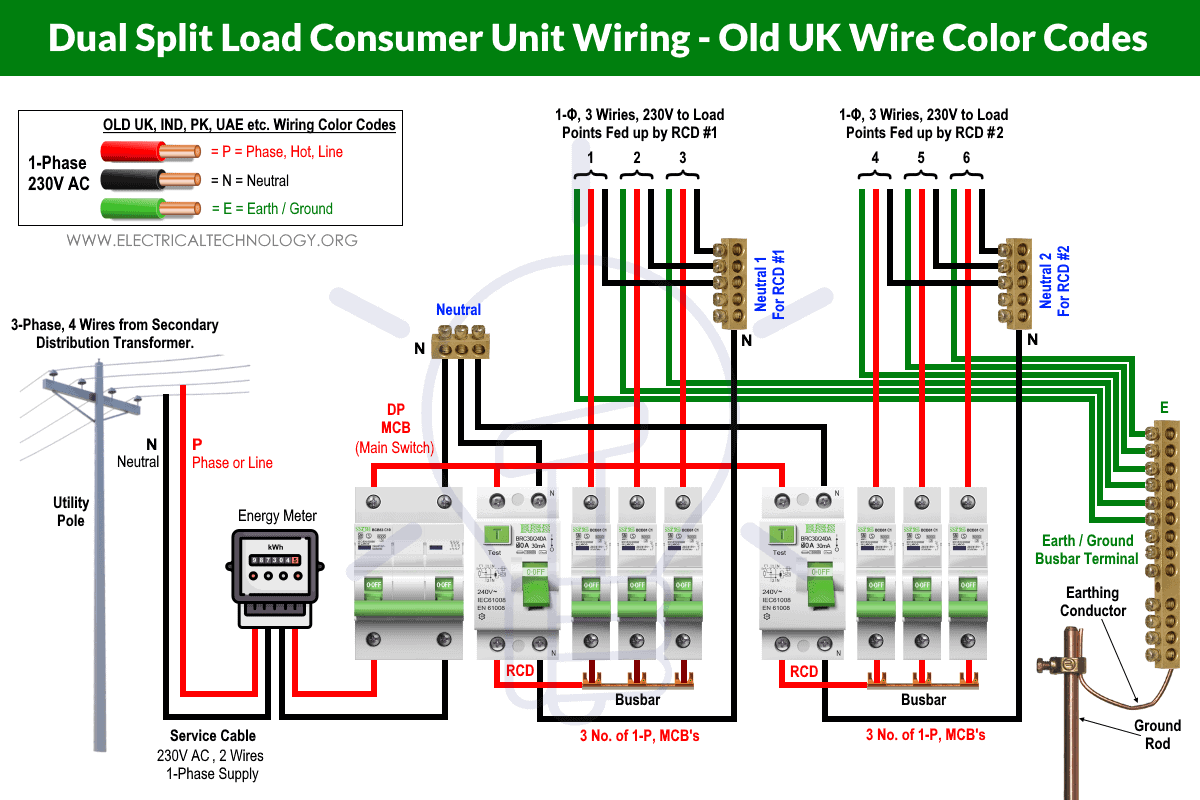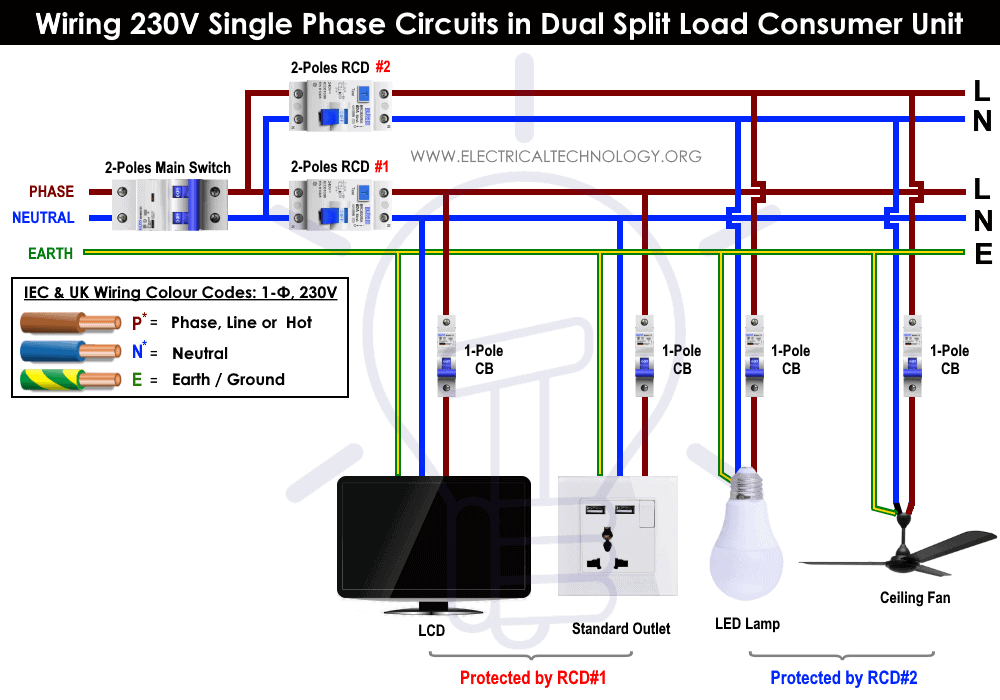How to Wire 230V Dual Split Load Consumer Unit? – RCD+MCB
Wiring a 1-Φ, 230V Dual Split Load Consumer Unit & Distribution Board : IEC, EU & UK
What is a Dual Split Load Consumer Unit?
Dual split load consumer unit contains a main switch breaker and two RCD’s to control two separate load points. These RCD’s will control and protect the circuits connected through associated single pole MCB circuit breakers.
For example, the main switch controls both the RCD’s while RCD#1 controls the load in separate sections (e.g. circuits in the downstairs) while RCD#2 controls and protects the load points in the other part of the residential area (e.g. circuits in the upstairs).
This is a cost effective solution in case of power failure as all the load points won’t shut at once. In other words, in case of fault on one RCD will not affect the load points controlled by the second RCD.
This dual RCD’s configuration will provide full earth leakage protection to appliances connected to the two sets of MCB banks. Keep in mind that never ever connect all the lighting points to the same RCD as you will face total darkness in case an earth leakage fault occurs on that associated RCD. In addition, contact a qualified electrician and follow all the rules and regulations, especially BS 7671, IEC, IET (17th & 18th Edition) while installing a consumer unit in domestics and residential areas.
Now let’s see how to wire a single phase, 230V dual split load consumer unit protected by two RCD’s in home.
Components Required:
- A Consumer Unit
- A Two Poles Main Switch MCB.
- 2 No of Two Poles RCD (Residual Current Device).
- 6 No of Single Poles MCB’s
- Cables and Wires.
Related Post:
How to Wire a Dual Split Load Consumer Unit?
The primary side of the distribution transformer is wires in Star or Y and supplied by the secondary side of power transformer (to reduce the level of voltage) while the secondary winding is in Delta.
The distribution transformer further step-down the supply voltage to 400V, three phase (three Lines + Neutral) and 230V single phase (Line and Neutral).
The Main switch (two poles MCB) in the dual split load consumer unit is connected to the two wires (Phase & Neutral) service cable from the secondary side of the distribution transformer mounted on the utility pole and energy meter. There is an additional fuse between transformer mounted on the utility pole and single phase kWh energy meter to isolate the power supply while troubleshooting / installing a kWh energy meter.
As shown in the fig below, the output phase wire from the double poles MCB as main switch is connected to both RCD’s while the neutral is connected to the common Neutral busbar terminal. The Neutral terminals of both RCD’s are connected to the common Neutral segment.
Now, the input of three single poles MCB’s (in the fist MCB bank) are fed up by RCD#1 and connected through the common busbar segment to RCD#1. Similarly, the input of three single poles MCB’s (in the second MCB bank) are fed up by RCD#2 and connected through the common busbar segment to RCD#2.
There are two additional and separate Neutral terminals (named as Neutral 1 for RCD#1 & Neutral 2 for RCD#2) assigned to each RCD’s.
Finally, the load points such as light bulbs, ceiling fan and socket outlet, washing machine, water heaters, electric motors etc. are connected via three wires such as Phase “P” (Brown Color) from the single pole MCB, Neutral “N” (Blue Color) from the Neutral terminal associated to specific RCD and the Earth / Ground “E or PE” (Green Color with yellow stripe).
Click image to enlarge
The earth busbar terminal in the CU is connected to the main earthing / grounding system (through earthing conductor ==> earth rod ==> and finally earth plate buried in the soil.
Good to know: RCD protection is a must in the consumer unit according to the IEC and 17th edition. You may read more about the differences between MCB, MCCB, ELCB & RCB, RCD or RCCB/RCBO Circuit Breakers before installation in the CU.
Related Posts:
- Single Phase Electrical Wiring Installation in Home – NEC & IEC
- Three Phase Electrical Wiring Installation in Home – NEC & IEC
Dual Split Load Consumer Unit Wiring – Old UK Wire Color Codes
The old UK wiring color codes (prior 2004) are still applicable in many countries such as IND, PAK, UAE, KSA and other countries. Before migrating to the IEC, the UK color codes for single phase 230V were Red for “Phase”, Black for “Neutral” and Green for “Earth/Ground) wire. The following fig shows the wiring of dual split load consumer units according to Old UK wiring color codes.
Click image to enlarge
Related Posts:
- Single-Phase Electrical Wiring installation in a Multi-Story Building
- 3-Phase & 1-Phase Electrical Distribution Wiring Installation in Multistory Building
Wiring 230V Single Phase Circuits in Dual Split Load Consumer Unit
In a single phase 230V consumer unit and distribution board. all the load circuits should be connected to the 230V AC supply via three wires i.e. Phase, Neutral and Earth/Ground wires.
The following fig shows how to connect single phase 230V load circuits in dual split load CU. For example, an LCD TV and LED Lamp is controlled and protected by RCD#1 and associated SP MCB’s while Ceiling Fan and socket outlet is protected and controlled by RCD#2 and associated SP MCB’s. The ON/OFF operation can be controlled electrical appliances can be controlled by final switches in the sub and final sun circuits.
Click image to enlarge
This way, the protection to the load points are as follows.
- LCD TV & LED Lamp Protected by Main Switch => RCD#1 => Single Pole MCB
- Ceiling Fan & Socket Outlet Protected by Main Switch => RCD#2 => Single Pole MCB
Related Posts:
- How to Wire 240V, 208V & 120V, 1 & 3-Phase, High Leg Delta Main Panel?
- How to Wire 277V & 480V, 1-Phase & 3-Phase, Commercial Main Service Panel?
IEC Wiring Color Codes – 1-Φ, 230V – UK & EU
Keep in mind that we have used IEC wiring color codes for illustration purposes only. If not applicable, Please follow the local area codes or general practiced color codes related to specific regions.
In the tutorials above, We have used the IEC wiring color codes (applicable to EU, UK and other countries) as follows.
UK & IEC Wiring Color Codes for 230V, 1-Phase, 2-Wire System
- Brown = Phase or Line Wire
- Blue = Neutral Wire
- Green or Green with Yellow Stripe = Ground or earth wire as protective earth (PE).
UK Old Wire Color Codes:
- Red = Phase or Line Wire
- Black = Neutral Wire
- Green = Earth / Ground .
Related Posts:
- How to Wire 120V & 240V Main Panel? Breaker Box Installation
- How to Wire 208V & 120V, 1-Phase & 3-Phase Main Panel?
Safety Precautions
- Disconnect the power supply (and make sure it is really swathed OFF) before servicing, repairing or installing electrical equipment. To do so, switch off the main switch in the main consumer unit or distribution board.
- Never stand or touch wet and metal parts while repairing or installation.
- Read carefully all the cautions and instructions and follow them strictly while doing this tutorial or any other work in practical related to electrical works.
- Always, use the right size cable and wire, proper size outlets and switch and suitable size of circuit breakers. You may also use the Wire and Cable size calculator to find the right gauge size.
- Never ever try to play with electricity (as it is dangerous and can be fatal) without proper guidance and care. Do the installation and repairing work in presence of experienced persons having vast knowledge and good practice who knows how to deal with electricity.
- Doing your own electrical work is dangerous as well as illegal in some cases. Contact the licensed electrician or the electric power supply provider before practicing any change/modification in electrical wiring connections.
- The author will not be liable for any losses, injuries, or damages from the display or use of this information or if you try any circuit in wrong format. So please! Be careful because it’s all about electricity and electricity is too dangerous.
Related Wiring Installation Tutorials:
-
- How to Wire and Install an Electrical Outlet Receptacle?
- How to wire a GFCI Outlet?
- How to Wire an AFCI Outlet?
- How to Wire Combo Switch and Outlet?
- How to Wire GFCI Combo Switch and Outlet
- How to Wire an AFCI Combo Switch
- How to Wire a GFCI Circuit Breaker?
- How to Wire an AFCI Breaker?
- Staircase Wiring Circuit Diagram – How to Control a Lamp from 2 Places?
- Corridor Wiring Circuit Diagram – Hallway Wiring using 2-Way Switches
- Tunnel Wiring Circuit Diagram for Light Control using Switches
- Hospital Wiring Circuit for Light Control using Switches
- Hotel Wiring Circuit – Bell Indicator Circuit for Hotelling
- Hostel Wiring Circuit Diagram and Working
- Godown Wiring Diagram – Tunnel Wiring Circuit and Working
- How to Wire 120V Water Heater Thermostat – Non-Simultaneous?
- Even More Electrical Wiring Installation & Tutorials










Show me the simple diagrams of fire alarm wiring systems.
Check the Fire alarm installation guide here..